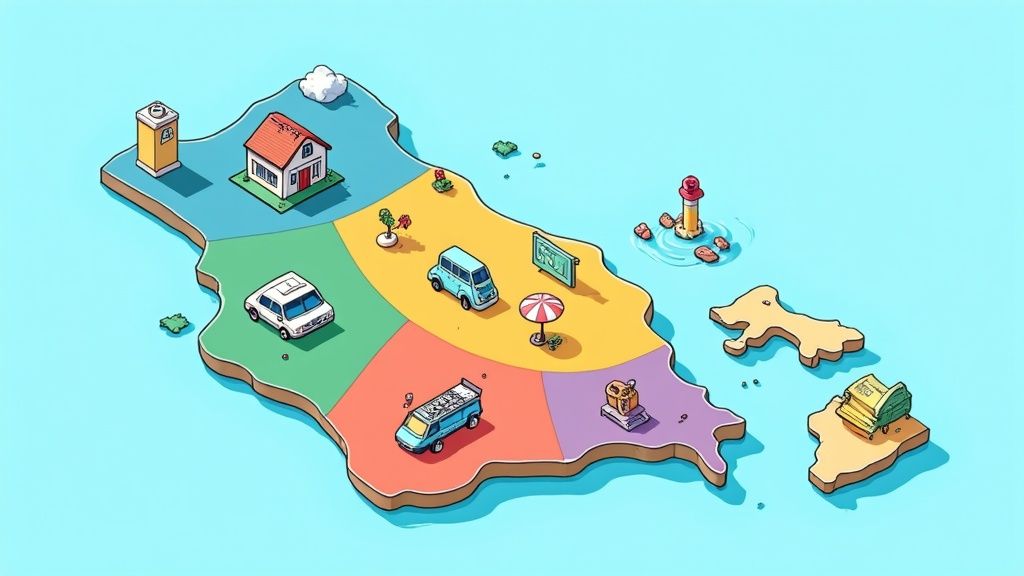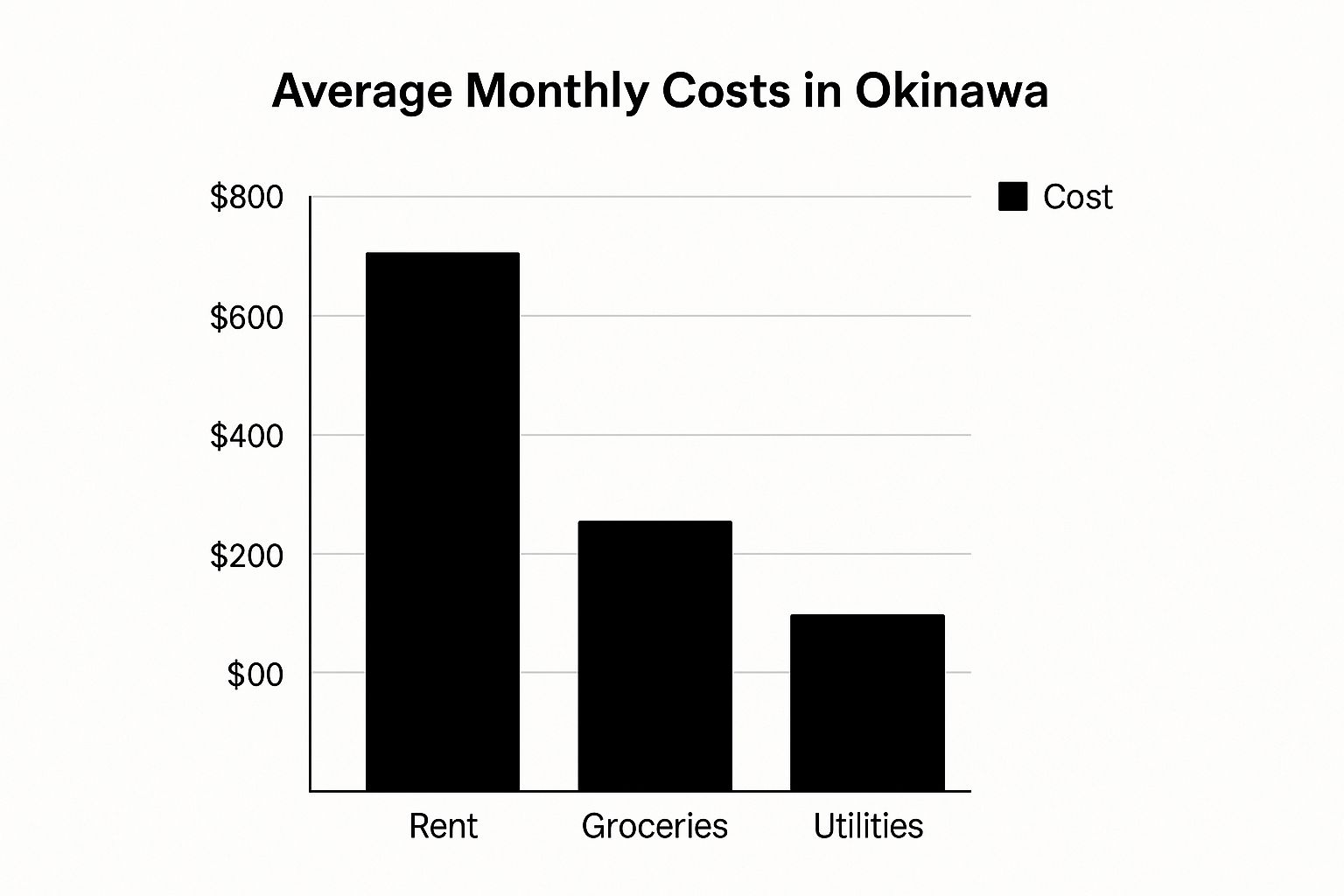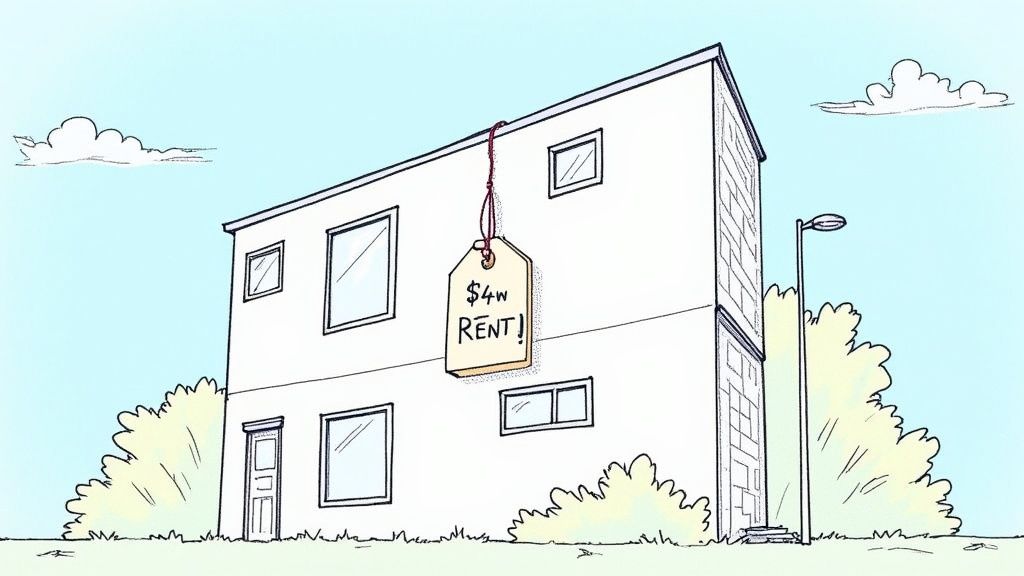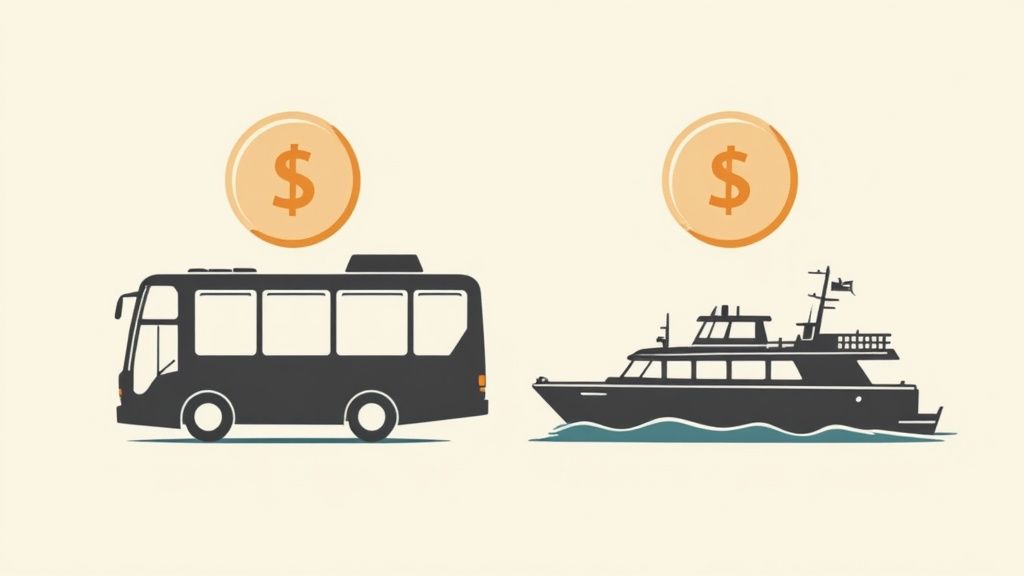Cost of Living Okinawa: Find Out the Real Expenses
Learn about the cost of living Okinawa with our comprehensive guide on housing, food, and transport costs to help you Budget for your Japan move.
Posted by

Thinking about a move to Okinawa? One of the first questions on your mind is probably, "What's it going to cost?" The good news is that living here is remarkably more affordable than on mainland Japan, letting you enjoy an incredible island lifestyle without the financial strain.
For a single person, you can live comfortably on a monthly budget between $1,900 and $2,200. That covers everything from your apartment to your daily ramen fix.
Your Quick Guide to Okinawa Living Expenses
Okinawa stands out as one of Japan’s most budget-friendly places to call home, a world away from the sky-high costs of cities like Tokyo or Osaka. Think of this guide as your starting point—a clear financial snapshot to help you build a budget that actually works for you on this beautiful island.
The image below breaks down the average monthly costs for the three biggest expense categories in Okinawa.

As you can see, housing takes the biggest slice of the pie, but it's far more manageable here than on the mainland. We'll dive deeper into each category, unpacking the numbers and the stories behind them.
Understanding the Financial Landscape
That estimated $1,900 to $2,200 a month for a single person is based on living in Naha, Okinawa's capital. If you're moving as a couple, you can expect your combined expenses to land somewhere around $3,200 per month—still a great deal compared to larger metropolitan hubs.
This affordability is a huge draw for expats and locals. But what makes it so much cheaper? A few key things come into play:
- Affordable Housing: Rent and property prices are just substantially lower than in Japan's major urban centers. It's as simple as that.
- Local Produce: Basing your diet around the amazing local Okinawan fruits and vegetables can seriously cut down your grocery bills.
- Relaxed Lifestyle: The island’s laid-back vibe naturally leads to spending less on pricey entertainment. You're more likely to spend your weekends at the beach than at an expensive club.
To give you a clearer picture, here's a quick summary of what those monthly costs might look like.
Estimated Monthly Cost of Living in Okinawa at a Glance
| Expense Category | Single Person (Est. Monthly Cost) | Couple (Est. Monthly Cost) |
|---|---|---|
| Housing | $700 - $900 | $1,000 - $1,300 |
| Utilities | $100 - $150 | $150 - $250 |
| Groceries | $300 - $400 | $500 - $700 |
| Transportation | $150 - $250 | $250 - $400 |
| Healthcare | $150 - $200 | $300 - $400 |
| Leisure | $350 - $450 | $600 - $800 |
| Total Estimate | $1,900 - $2,200 | $3,200 - $3,850 |
These figures are a solid starting point, but of course, your personal spending habits will shape your final budget.
This financial accessibility makes Okinawa one of the most attractive destinations in the country. To see how it stacks up against other budget-friendly spots, take a look at our guide on the cheapest places to live in Japan.
Now, let's get into the nitty-gritty of each expense category so you can plan your move with confidence.
Decoding Okinawa Housing and Rent Prices
For most people, housing is the single biggest line item in their budget. But here in Okinawa, it's where you'll find your most significant savings. It’s a game-changer. Imagine swapping a cramped, overpriced city apartment for a place with an ocean breeze—that’s the reality of the Okinawan housing market, and it’s a key reason the overall cost of living is so much lower here.
This isn't just a feeling; the numbers back it up. Japan is in a unique situation with a massive oversupply of properties. As of May 2025, government data showed a staggering nine million vacant houses across the country. This has pushed prices down dramatically, with some properties selling for under $10,000 USD. For renters, the difference is just as stark. A one-bedroom apartment outside the city center here averages just $382.21 a month. Compare that to Tokyo ($544.61) or even Nagoya ($686), and you start to see the appeal. To get a better sense of what’s driving these trends, you can find more about the factors influencing Japan housing prices in our detailed article.

Navigating the Rental Market
When you start looking for an apartment, you'll run into some unique Japanese terms for layouts. Getting a handle on these is the first step to finding a place that fits your life and your budget.
- 1K/1DK: These are compact, perfect for a single person. A "1K" gives you one main room plus a separate kitchen. A "1DK" is similar but with a slightly larger "dining kitchen" space. In a city like Naha, you can find these for around ¥50,000 - ¥70,000 ($320 - $450 USD) per month.
- 1LDK/2LDK: A great fit for couples or small families. These offer one or two bedrooms along with a combined "living, dining, kitchen" area. A "2LDK" in a family-friendly spot like Ginowan could run you ¥80,000 - ¥120,000 ($515 - $770 USD).
Of course, where you choose to live matters a lot. A sleek, modern apartment in downtown Naha will cost more than a similar-sized place in a laid-back village like Nago up north. It's also worth noting that rents can be higher near U.S. military bases, as landlords know they can often get more from tenants with housing allowances.
The key takeaway is that your housing cost is incredibly flexible. Just by choosing a location slightly outside the main city centers, you can unlock huge savings and free up a good chunk of your monthly budget for everything else Okinawa has to offer.
Understanding Japanese Move-In Costs
Okay, this is where things get a little different. Renting in Japan isn't just about paying the first month's rent and a security deposit. There's a whole system of upfront fees that can catch newcomers by surprise, so it's vital to budget for them.
Think of it as the "entry fee" for your new home. These initial costs often add up to 3 to 5 times your monthly rent, and you'll pay it all before you get the keys. Here’s what it typically includes:
- Security Deposit (Shikikin): This is the familiar part. It’s a refundable deposit, usually one or two months' rent, to cover any potential damages.
- Key Money (Reikin): This one is less familiar. It’s a non-refundable "gift" to the landlord, often one month's rent. It’s a long-standing custom, though thankfully, it's becoming less common.
- Agency Fee (Chukai Tesuryo): Your payment to the real estate agent who helped you find the place. It's almost always one month's rent, plus tax.
- Guarantor Company Fee: Since most non-Japanese residents don't have a local relative to co-sign, you'll pay a company to act as your guarantor. This fee is usually between 50-100% of one month's rent.
- First Month's Rent: You'll pay this in advance, of course.
While that initial hit can seem like a lot, remember the bigger picture. The much lower monthly rent you'll be paying over the long term is what makes Okinawa's housing market so attractive. Just plan for these upfront costs, and you won't have any nasty surprises.
Budgeting Your Daily Life and Utilities
Once you’ve sorted out your rent, it’s the day-to-day costs that really define your budget. Things like groceries, your electric bill, and your phone plan are the steady drumbeat of your monthly spending in Okinawa. Getting a handle on these recurring expenses is the secret to living comfortably on the island without financial stress.

Let's break down what you can realistically expect to pay for everything from your morning groceries to your evening internet connection. This will help you build a true-to-life picture of what it costs to live here.
Navigating Okinawa's Grocery Aisles
Your food bill is probably the most flexible part of your entire budget. What you spend really comes down to your shopping habits. Big supermarkets like San-A, Aeon, and Union are great for one-stop shopping and carry plenty of familiar Western goods, but that convenience can sometimes cost a little extra.
If you want a more local—and often cheaper—experience, make a beeline for the farmers' markets (JAファーマーズマーケット) or the small, family-run shops in your neighborhood. This is where you'll find heaps of fresh, seasonal Okinawan produce like goya (bitter melon), beni imo (purple sweet potato), and shikuwasa (a tart local citrus). Centering your meals around local ingredients is not just good for your health; it's fantastic for your wallet.
A single person can typically expect to spend around ¥35,000 to ¥50,000 ($225 - $320 USD) a month on groceries.
To help you visualize this, we've put together a sample shopping list with typical prices for common items you'd find in your cart.
Sample Weekly Grocery Basket in Okinawa
| Grocery Item | Average Price (JPY) | Notes |
|---|---|---|
| White Rice (5kg) | ¥1,800 - ¥2,500 | A staple in any Japanese home. Price varies a lot by brand and quality. |
| Chicken Breast (1kg) | ¥800 - ¥1,200 | Locally sourced chicken is often fresher and a bit more affordable. |
| Eggs (10 pack) | ¥250 - ¥350 | A versatile and cheap source of protein. |
| Goya (Bitter Melon) | ¥100 - ¥200 | An Okinawan superfood that's incredibly inexpensive when it's in season. |
| Tofu (1 block) | ¥80 - ¥150 | Island-style "shima dofu" is firm, delicious, and a must-try. |
| Orion Beer (6-pack) | ¥1,100 - ¥1,300 | Okinawa's famous local beer is a common sight in shopping baskets. |
| Milk (1 liter) | ¥200 - ¥280 | Dairy can be a little pricier here compared to mainland Japan. |
The best strategy? Mix it up. Grab your pantry staples at a large supermarket and then hit the local markets for fresh produce. It's the perfect way to keep your food budget in check.
Understanding Your Monthly Utility Bills
Utilities—electricity, gas, and water—are a fact of life, and in Okinawa, their costs can really swing with the seasons. For a single person living in a typical one-bedroom apartment, the combined bill usually lands somewhere between ¥10,000 and ¥15,000 ($65 - $95 USD) per month.
But that's just an average. The time of year makes a huge difference.
- Summer (June-September): Get ready for your electricity bill to jump. Okinawa's summers are intensely hot and humid, making air conditioning an absolute necessity, not a luxury. It's not uncommon for your bill to double in July and August.
- Winter (December-February): While winters are mild, you’ll probably find yourself using a space heater on chillier nights, which will bump up your electricity usage. Gas costs might also creep up from taking longer, hotter showers.
Water and gas bills are generally more consistent. Most apartments here run on Liquid Petroleum Gas (LPG), which is delivered in tanks and tends to be a bit more expensive than the city gas you'd find in places like Tokyo or Osaka.
Here's a pro tip for managing your bills: get a good dehumidifier. By pulling moisture out of the air, it makes your apartment feel much cooler, so you can run the A/C less. As a bonus, it also helps prevent mold, which can be a real problem in this climate.
Staying Connected: Internet and Mobile Plans
A solid internet connection and a reliable phone are non-negotiable these days. Thankfully, Okinawa has a competitive market, so you can find some great deals if you shop around.
For home internet, you can easily get a high-speed fiber optic connection for around ¥4,000 to ¥6,000 ($25 - $40 USD) a month. Many companies will even offer you a discount if you bundle your internet with a mobile plan.
Speaking of mobile plans, you have a ton of choices. The big three—Docomo, au, and SoftBank—offer premium service with widespread coverage, but you'll pay a premium for it.
If you want to save some serious yen, look into a Mobile Virtual Network Operator (MVNO). Companies like Rakuten Mobile, UQ Mobile, or Y!mobile use the same networks as the major carriers but offer plans for a fraction of the price. You can often find a great plan with plenty of data for as little as ¥2,000 ($13 USD) per month. It's a simple switch that can make a big dent in your monthly spending.
Getting Around the Island on a Budget
Okinawa is an island that practically begs you to explore it, from the buzz of Naha to the quiet, hidden beaches up north. How you decide to get around will play a huge role in your monthly budget, not to mention your overall experience here. Your transportation choice really does define your freedom.

While mainland Japan is famous for its incredible train systems that run like clockwork, Okinawa moves to a different beat. The options are more limited, making the decision between public transport and your own car a critical one for both your bank account and your lifestyle.
The Car Ownership Question
For most people living here, a car isn't really a luxury—it's the key that unlocks the island. Once you get outside of Naha, public transportation gets a lot patchier. A car gives you the flexibility to find those remote coves, visit the historical sites in the north, or just make a simple trip to the grocery store a whole lot easier.
But owning a car is much more than just the sticker price. It's a bundle of recurring costs you need to plan for. Think of it less as a one-time purchase and more as a subscription to your freedom on the road.
Here’s a rough idea of what you’ll be looking at:
- Buying a Car: The used car market is your best friend here. You can find a reliable little "kei" car (the ones with the yellow license plates) for as little as ¥200,000 to ¥400,000 ($1,300 - $2,600 USD).
- Compulsory Insurance (JCI): This is the mandatory insurance everyone has to have. It's bundled into your vehicle inspection.
- Voluntary Insurance: You'll definitely want this for more complete coverage. Costs can vary, but a good estimate is around ¥5,000 - ¥10,000 ($32 - $65 USD) per month.
- Road Tax: This is an annual tax based on your car's engine size, which you'll pay every May. For a small car, it's typically between ¥7,200 to ¥34,500 ($46 - $220 USD) a year.
- Parking: If your apartment doesn't come with a parking spot, you'll have to rent one. This can set you back anywhere from ¥5,000 to ¥15,000 ($32 - $96 USD) a month, depending on where you live.
Navigating the Shaken Inspection
The biggest recurring expense for any car owner in Japan is the mandatory vehicle inspection, known as shaken (車検). This is not your quick, 15-minute emissions test. It’s a thorough, bumper-to-bumper inspection that has to be done every two years.
The shaken is a major financial checkpoint for any car owner. It ensures vehicles are safe and roadworthy, but it comes at a price. Budgeting for it well in advance is essential to avoid a costly surprise.
The total cost for a shaken can run from ¥80,000 to over ¥150,000 ($515 - $965 USD), depending on the condition of your car and any repairs needed to pass. This fee covers the inspection itself, the renewal of your compulsory JCI insurance, and a weight tax.
Life Without a Car
So, can you actually live a good life in Okinawa without your own set of wheels? Absolutely, especially if you plan to stick close to the capital city, Naha. The public transport network here is perfectly usable, even if it isn't as vast as Tokyo's or Osaka's.
These are your main options:
- Yui Monorail: This is the heart of Naha's public transit. The elevated train line runs from Naha Airport right through the city center, hitting key spots like Kokusai Dori and Shuri Castle. It’s clean, on time, and great for getting around the city.
- Bus Network: An extensive bus system spiders out across most of the island, reaching places the monorail can't. They're reliable, but once you get into the more rural areas, the schedules can be pretty infrequent, so you'll need to plan your trips carefully.
- Taxis and Ride-Sharing: Taxis are easy to find but can get pricey, especially for long distances. Ride-sharing apps like Uber are around, but they basically just call a regular taxi for you, not the peer-to-peer model you might be used to.
In the end, it all comes down to the kind of life you want to live here. If you dream of spending your weekends discovering remote coastlines, a car is pretty much non-negotiable. But if you’re more of a city person who’s happy with planned trips now and then, you can save a good chunk of money by relying on public transport.
How Much Does the Okinawan Lifestyle Actually Cost?
Alright, let's talk about the fun stuff. Once you’ve sorted out the essentials like rent and groceries, you get to budget for what makes living in Okinawa so special. This is where you move from just existing to truly living.
The real beauty of life here is that you can have an incredible time without torching your bank account. The island is this amazing mix of ancient Ryukyuan culture, jaw-dropping nature, and modern fun. Figuring out your leisure budget is less about numbers and more about what you love to do. Are you a foodie? A beach bum? A history buff? Whatever it is, you can build a rich, exciting life here.
Eating Out: From Cheap Eats to Ocean Views
The food scene in Okinawa is fantastic, and you'll probably find yourself eating out more than you'd expect. It’s just that good—and that affordable.
At the heart of it all is the classic shokudo (食堂). Think of these as no-frills, local diners that serve up seriously good, home-style Okinawan food. You can get a hearty bowl of Okinawa soba or a plate of goya champuru for about ¥700 to ¥1,000 ($4.50 - $6.50 USD). They're my go-to for a quick, delicious, and incredibly cheap lunch.
For a night out with friends, you can’t beat an izakaya (a Japanese pub). You'll share small plates, have a few drinks, and a great time. An evening like that will probably run you somewhere between ¥3,000 and ¥5,000 ($20 - $32 USD) per person. If you're planning something a bit more special, like a date night, there are plenty of beautiful seaside restaurants. A nice dinner for two with those killer ocean views will typically be in the ¥6,000 to ¥10,000 ($40 - $65 USD) range.
Getting into the local food culture is a huge part of the experience. Your food budget can be as simple as a tasty bento box from the convenience store or as elaborate as a multi-course meal. It's totally up to you.
Fun That's Free (or Almost Free)
One of the best perks of living on a subtropical island? The greatest attractions don't cost a thing. Nature is your playground here, and it’s a world-class one.
- Beach Hopping: This will quickly become your default weekend plan. Relaxing on postcard-perfect sand and swimming in turquoise water at places like Manza Beach or Emerald Beach is completely free. You might just have to pay a small fee for parking or to rent an umbrella.
- DIY Snorkeling: Forget expensive tours. Just grab a mask and snorkel, and you can explore stunning coral reefs packed with tropical fish right from the shore. So many of the best spots are easy to get to and cost absolutely nothing.
- Castle Ruins: Okinawa is covered in the ruins of the old Ryukyu Kingdom, and many are even UNESCO World Heritage sites. Some of the bigger ones, like Shuri Castle, have an entry fee, but you can explore others like the Nakagusuku Castle Ruins for just a few hundred yen.
- Hiking in the North: Head up to the northern part of the island, known as Yanbaru, to find hidden waterfalls and wander through lush subtropical forests. The trails are all free and a perfect way to escape into nature.
Honestly, you can fill your entire calendar with these kinds of amazing experiences week after week. It's a huge reason the overall cost of living in Okinawa feels so manageable.
Hobbies, Gyms, and Social Life
Staying active and social is part of the lifestyle, and it won't break the bank either. A monthly gym membership usually costs between ¥7,000 and ¥10,000 ($45 - $65 USD), and most places are well-equipped with modern machines and classes.
Of course, the water is a huge draw. Getting into scuba diving or paddleboarding is incredibly popular. While getting your PADI certification is an initial investment, the cost per dive after that is pretty reasonable.
When the sun goes down, the social scene picks up in spots like Naha's Kokusai Dori or the Sunabe Seawall in Chatan, which are always buzzing with locals and expats. Grabbing a locally brewed Orion beer will usually set you back about ¥500 - ¥700 ($3.20 - $4.50 USD).
In the end, what you spend on entertainment is your call. You could have weekends full of diving trips and dinners out, or you could pack a picnic and enjoy the island’s natural beauty for free. That flexibility is what makes the Okinawan lifestyle so amazing.
Putting It All Together: What Will Your Okinawa Budget Look Like?
Okay, we've broken down the average costs, but what does that actually mean for you? The truth is, there's no single magic number for the cost of living in Okinawa. It all comes down to your lifestyle, where you choose to live, and what you prioritize.
Let's move from averages to real-world examples. I've sketched out a few sample monthly budgets to give you a clearer picture of how different people manage their finances on the island. Think of these as starting points to help you build your own.
A Few Budget Snapshots
Everyone's spending tells a story. A young professional is going to have a very different budget from a family of four. Let’s take a look.
- The Single English Teacher: Making a steady ¥250,000 (~$1,600 USD) a month, they can live comfortably but need to be mindful. Their biggest expense is rent for a compact 1K apartment in a place like Ginowan, which is close to everything. After that, it's groceries and keeping their small car fueled up for weekend adventures.
- The Military Family (Living Off-Base): Their finances are often structured around a housing allowance (BAH). This might allow them to rent a spacious 3LDK home in a popular area like Chatan for around ¥180,000 (~$1,150 USD). Naturally, their utility bills will be higher for the bigger space, and they’ll spend more on groceries and family activities.
These examples really show how adaptable life in Okinawa can be.
Your budget is a personal blueprint, not a rigid set of rules. Use these profiles as inspiration. Tweak the numbers and categories to match what you value most, whether that’s eating out every week, saving up for scuba gear, or building a nest egg.
Comparing Different Lifestyles
Even in the same affordable setting, your daily life will shape your spending dramatically. A digital nomad and a retired couple, for instance, are playing completely different games.
- The Digital Nomad: With a fluctuating income, keeping fixed costs low is key. They might grab a cheaper apartment a bit further from the city center and get around on a scooter to save on transport. Their "fun" budget is probably a bit bigger, covering co-working passes, café-hopping, and flights to nearby islands.
- The Retired Couple: Living on a fixed pension, their focus is on comfort, stability, and health. They might own their home outright, wiping out the rent column completely. Instead, they’ll allocate more of their budget to healthcare, hobbies like gardening, and enjoying the island's fantastic restaurants at a leisurely pace.
At the end of the day, Okinawa's affordability is what makes it so appealing to so many different people. The numbers back this up, too. For 2025, Okinawa has the lowest average monthly household spending among Japan's major regions, coming in at just ¥192,262 (about $1,400 USD).
That's a world away from the Kanto region (where Tokyo is), which averages ¥265,914. It proves that you can find an incredible quality of life here without breaking the bank. For a deeper dive, you can see how these living costs compare across Japan.
Answering Your Top Questions About Living in Okinawa
To wrap things up, let's get into some of the questions I hear all the time from people thinking about making the move. These are the practical, need-to-know details that will help you feel truly prepared for your new life on the island.
Is Okinawa Really Cheaper Than Mainland Japan?
Absolutely. The cost of living in Okinawa is noticeably lower than in Japan’s big urban centers like Tokyo or Osaka. You'll feel the difference most in your rent, which can be a staggering 50-60% cheaper than what you’d pay for a similar place on the mainland.
Day-to-day spending on groceries and eating out also tends to be more budget-friendly. While you might pay a little extra for certain imported goods because of shipping, your overall budget will go so much further here. It’s a huge part of what makes the quality of life so high. For a bigger picture on what it's like to adapt, you can read our guide on life in Japan as a foreigner.
Can I Get by Without a Car?
It honestly depends on your lifestyle and where you decide to plant your roots. If you’re living right in Naha, you can definitely manage without a car. The Yui Monorail, a solid bus network, and your own two feet can get you almost anywhere you need to go within the city.
But if you dream of exploring Okinawa’s hidden gems—those secluded beaches, jungle cafes, and historic castle ruins—a car is pretty much essential. Once you leave the city limits, public transport thins out dramatically. For anyone not living in the heart of Naha, a car is less of a luxury and more of a necessity.
A car is your ticket to freedom here. While you can survive in the city without one, it’s what truly unlocks the adventurous spirit of Okinawa that brings so many of us to the island in the first place.
How Much Money Should I Have Saved Before I Move?
Having a solid financial buffer is one of the smartest things you can do for a stress-free move. I always recommend saving at least three to six months' worth of your projected living expenses before you even get on the plane. A big chunk of this will go toward the upfront costs of securing an apartment.
Be prepared for the initial rental fees, which can include a security deposit, first month's rent, "key money," and an agency fee. All told, this can easily add up to 3 to 5 times your monthly rent. As a ballpark figure for a single person, aiming for $5,000 to $8,000 USD is a good target. That should give you enough to cover the move-in costs, buy some furniture, and handle any surprises while you get settled.
Ready to turn your dream of island life into reality? At mapdomo, we make finding your perfect home in Japan simple. Explore thousands of listings, from modern apartments in Naha to traditional houses in the countryside, all with our easy-to-use interactive maps. Start your search today and discover your new home at https://mapdomo.com.